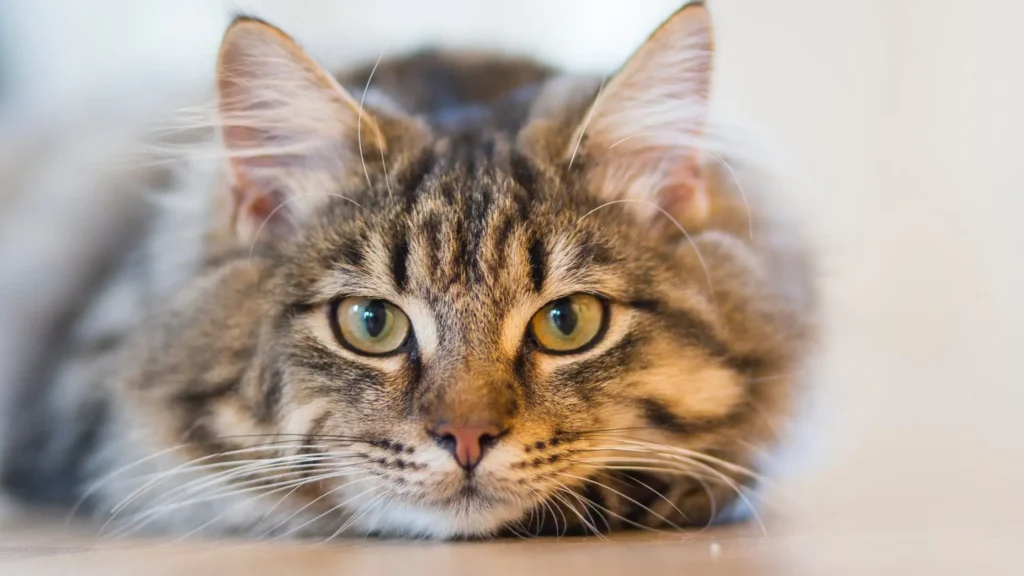Cat’s Body Language: Cats are fascinating and complex creatures. Their unique behaviors and mysterious moods often leave owners guessing what their feline friends are trying to communicate. Learning to decode your cat’s body language is key to strengthening your bond and providing them with the best care.
This comprehensive guide will teach you how to interpret your cat’s postures, movements, and vocalizations so you can better understand their needs.
Why Understanding Cat Behavior Matters
Cats have lived closely with humans for thousands of years but still retain many of their wild instincts. This means their behavior and communication styles differ significantly from dogs and people. Unlike dogs, cats did not undergo selective breeding to enhance their ability to communicate with humans.
As solitary hunters, cats are masters of subtle body language. The key to decoding your cat lies in spotting these nuanced physical and vocal cues. Taking the time to understand what your cats is trying to tell you, benefits your relationship in many ways. More specifically it allows you to:
- Take better care – You can identify when your cat is sick, stressed, anxious, or needs something. This allows you to address issues promptly.
- Prevent problems – Catching subtle signs of fear, aggression, or discomfort early helps prevent behavior issues.
- Enrich the bond – Understanding your cat helps them feel safe and deepens your friendship.
- Reduce stress – Daily interactions and care cause less anxiety when owners understand cats.
- Improve training – Insights into your cat’s motivations and learning style aid positive reinforcement training.
While cats will always be more challenging to read than dogs, making the effort to decode their unique body language and vocalizations offers big rewards to both owner and cat.
Reading Your Cat’s Body Language
Cats use their entire body to communicate how they are feeling. The key is knowing what to look for in their posture, facial expressions, tail, ears, and more. Here’s a guide to the meaning behind common cat behaviors:
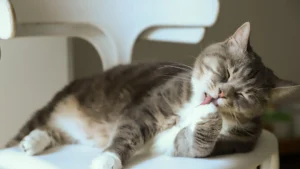
Posture
Your cat’s overall body posture provides significant clues to their emotional state:
- Relaxed posture – Body loose and floppy, muscles soft, laying on side. Indicates contentment.
- Tense posture – Body taut, muscles rigid, upright stance. Signals anxiety, fear, or aggression brewing.
- Crouched posture – Body lowered, muscles coiled, ready to spring. Readies for attack or defense.
- Prostrate posture – Body flat, legs splayed, stays still. Used to show submission or redirect aggression.
Facial Expressions
A cat’s face speaks volumes about their mood. Here’s what to look for:
- Eyes – Relaxed eyes are half-closed or narrowed. Wide open eyes with dilated pupils signal fear or aggression.
- Ears – Erect, forward-facing ears show interest and contentment. Flattened ears indicate anger, fear, or discomfort.
- Whiskers – Neutral whiskers mean calmness. Angry or tense cats push their whiskers back.
- Muzzle – Relaxed cats often hold their mouths slightly open. Anxious cats close their mouths and pull back their lips.
Tail
Cats use their seats like a mood ring:
- Upright – Holing tail high is a sign of happiness and confidence. Waving a vertical tail shows excitement.
- Twitching – A twitching or thrashing tail indicates irritation, anxiety, or anger brewing.
- Puffed – A bottle-brush tail signals fear or aggression. Watch out for biting or scratching!
- Down – Lowered or tucked tail indicates insecurity or retreat.
- Wrapped around – Wrapping the tail around the body shows contentment and trust. Wrapping around a person’s leg is a friendly greeting.
Ears
Cat ears are highly mobile and communicative:
- Forward – Erect ears facing forward signal interest, trust, and contentment.
- Swiveling – Scanning ears and taking in all sounds indicates alertness.
- Flat – Flattened ears show anger, fear, or distress.
- Rotated – One ear twisted back signals ambivalence. Both ears back express rising irritation or anxiety.
- Head shaking – A head shake while ears are flat often signifies irritation or discomfort.
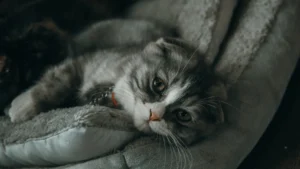
Whiskers
A cat’s sensitive whiskers provide insight into their comfort levels:
- Neutral – Whiskers naturally jut out when the cat is relaxed.
- Pulled back – Anxious or irritated cats will pull their whiskers back against their faces.
- Forward – Whiskers pushed forward signals curiosity and interest.
- Stroking – If your cat gently bumps your hand with their whiskers, they bond with you.
Head
How a cat holds their head can reveal their frame of mind:
- Up – Head held high signals confidence and alertness.
- Neutral – Head at relaxed, natural angle shows calmness.
- Lowered – Head lowered signals defensive, anxious, or depressed mood.
- Rubbing – Rubbing the head on objects/people marks territory and shows affection.
Back
A cat’s back posture and movement provide additional clues:
- Arched – Back arched up indicates fear. Raised fur along the spine adds to the fearful appearance.
- Lowered – Keeping back horizontal shows a relaxed mood.
- Rippling – Rippling skin or twitching back shows irritation and overstimulation.
- Curling – Curling around a person’s legs shows affection and comfort.
Cat Vocalizations and What They Mean
Cats have an extensive vocal repertoire to express their moods. Here’s how to interpret feline vocalizations:
- Purring – This contented rumble is a sign of happiness and comfort. But cats sometimes purr when stressed as a self-soothing mechanism.
- Meowing – Can indicate excitement, loneliness, hunger, or anxiety. Context offers clues to a meow’s meaning.
- Trilling is a friendly vocalization reserved for bonded humans showing happiness and affection.
- Chirping – Used to greet owners or get another cat’s attention and also used while birdwatching or hunting.
- Growling – Low growls are warnings to back off due to fear, pain, or resource guarding.
- Hissing – This cat’s version of “go away!” Signals fear, aggression, or defensive aggression.
- Yowling – Persistent loud meows indicate extreme distress, separation anxiety, hunger, or pain.
- Howling – Long, drawn-out meows can signify anxiety, confusion, cognitive decline, or reactiveness to noises.
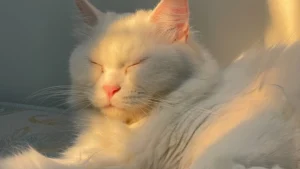
Tips for Understanding Your Cat Better
- Observe context – Consider the whole situation, not just isolated signals. The context makes the behavior meaningful.
- Track patterns – Make notes on when your cat uses certain behaviors so you can detect patterns.
- Consider history – Past experiences may shape how your cat communicates. For example, anxious cats may stay hypervigilant.
- Give them agency – Let your cat walk away if they seem uncomfortable. Forcing interactions stresses them.
- Adjust interaction pace – Go slow with easily startled cats. Cats that crave attention thrive on more interaction.
- Provide resources – Ensure your cat has “safe spaces” to retreat to, high perches, scratching posts, water, a clean litter box, etc. So they feel less anxious day-to-day.
- Use food rewards – Food-motivated training and play can build confidence in fearful cats.
- Consult an expert – If you can’t pinpoint the trigger for behaviors like aggression or inappropriate elimination, seek help from a cat behaviorist.
The Benefits of Understanding Feline Body Language
Though it takes some detective work, learning your cat’s unique communication style has big payoffs. You’ll enjoy a better friendship with your cat when you can interpret their needs correctly. Additionally, identifying minor mood changes early helps avoid behavior problems before they start. With time and patience, you can translate your cat’s subtle body language fluently. The rewards for your bond with your feline friend make the effort well worth it.
FAQ about Cat’s Body Language
Here are answers to frequent questions owners have about interpreting cat behaviors and moods:
Why does my cat stare at me?
Direct staring can mean a few things. A long, relaxed gaze shows affection for owners. More intense staring may indicate hunger and curiosity, or your cat is asserting their dominance.
What does it mean when my cat rubs against me?
Bunting or head butting deposits the cat’s scent on you, marking you as theirs. It shows trust and affection.
Why does my cat knead me?
Gentle kneading or “making biscuits” harkens to kittens kneading their mother to stimulate milk. Adult cats do it when they feel content.
What does it mean if my cat hisses?
Hissing universally signals that your cat feels threatened or fearful. Give them space until they are no longer hissing.
Why do cats wag their tails?
Unlike dogs, a wagging cat’s tail does not mean happiness. It often indicates irritation, overstimulation, or anxiety. Look at their whole body language before deciding if they are content.
Conclusion
Decoding your cat’s body language and vocalizations takes work, but it allows you to peer inside their mysterious world. By understanding your cat’s postures, facial expressions, tail movements, ear positions, and vocal cues, you can better provide for their needs and strengthen your bond.
While cats will always retain their independent spirit, trying to understand what they are trying to tell us benefits the relationship immeasurably. Use these feline body language tips to become fluent in your cat’s unique communication style. When you interpret their messages correctly, you will enjoy a more profound friendship with your fascinating feline companion.
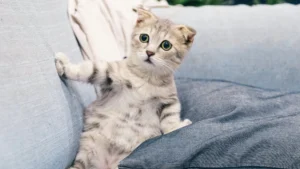
Useful Equipment
Let us know down below if you found this article helpful. Are there any other questions you would like us to answer?
If you are a cat or pet lover in general here are a few more articles you may find interesting:
- FINDING THE PERFECT NAME FOR YOUR CAT
- WHY DO CATS HATE WATER SO MUCH? THE COMPLETE GUIDE FOR CAT OWNERS
- THE TOP 10 MOST EXPENSIVE CATS IN THE WORLD
- HOW TO TRAIN A KITTEN TO USE A LITTERBOX
- THE TOP 10 MOST POPULAR CAT BREEDS IN THE WORLD

